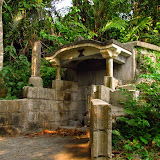 |
| The grave of the Kanna Noro |
View Map It! Okinawa in a larger map
 |
| Grave of the Kanna Noro |
GPS
| Latitude | Longitude |
| N 26 28.500 | E 127 57.680 |
The Grave of the Kanna Noro, Ginoza Village
In a small corner of Kanna, Ginoza is a grave belonging to the Kanna Noro. A noro (nuuru, ヌール, pronounced in the Okinawan language) was a priestess normally assigned by the old Ryukyu Government.(1) Noro's were dispatched to local areas, often to lead spiritual ceremonies aimed to bring prosperity and a good harvest to the village.(2) This particular area of Kanna where she is buried is called Kanna Machigushiku (カンナ マチグシク).(2)
Her Title. In Japanese her name is written as 漢那祝女雲上. In the Roman alphabet this is pronounced as the 'Kanna Noro Kumi'. The kanji for kumi (雲上) can also be pronounced as unjō meaning to be 'above the clouds' or ' from the heavens'. In this case, kumi would be an honorific and when put together, her entire name can be loosely translated as the 'Kanna Noro from the Heavens'.(i)
A Mystery Figure. According to the Ginoza Office, this particular noro was known for her beauty, so much that it became a topic in some local poems. There is a verse written in Japanese that was provided on the explanation sign near her grave. Translated it reads, "To the north, the Kanna Noro shines and from the southern region, the hansom Kabira Yamato". The Ginoza Office does not elaborate who this Kabira Yamato was or where he comes from. He remains a mystery figure at the moment.(iii)
i The translator who is familiar with Okinawan history suggested that the honorific of kumi had more to do with the ranking system among the noro's. The author has no hard reference to support this (at the moment), but this leads to a broader question about the hierarchical relationship within the noro ranking system. It is with most certainty that an established hierarchy existed. In fact under King Sho Shin, the 3rd successor in the Second Sho Dynasty, a structure was created to formalize the noro system.(3) To what degree is not certain by the author. The supreme priestess was given the title Kikoe Ogimi. (3)
ii. The poem verse written in Japanese is written as follows: “上に豊まれる漢那のろこもえ下に豊まれる川平山戸”
iii. Conjecture. The way it is written, Kabira Yamato could mean Kabira's Yamato taking on a possessive form. In this case, Kabira could be a region, and thus Yamato would be a man from that area. There is a Kabira Bay located in Ishigaki Island which is part of the Yaeyama chain of islands, and is part of the southern region of Okinawa.
iv. The explanation sign does not give the year of the noro's death or what time span she lived in.
v. The current grave seems to be made of modern construction, quite possibly renovation was done to the earlier grave site.
References.
1. Women of the Sacred Grove, Susan Sered, Oxford University Press 1999, Pg 18.
2. Explanation sign on location, Ginoza Office, March 2011.
3. The Government of King Sho Shin, website, Okinawa Prefectural Board of Education
Directions. Take Highway 329 North into Ginoza Village. The old Kanna Thalasso Health Spa building will be to your right. Once you pass this you will be going up the hill. Make the next right. There will be an open field next to an apartment building. Near the back of the field you will see a sign and a guide rail leading you to the grave site.
Other places to visit nearby. The Yoriage Forest, The Weenuatai Ohaka, The Kanna Dam.
No comments:
Post a Comment